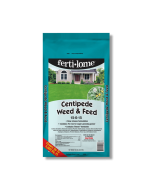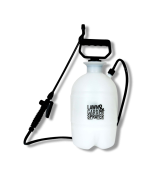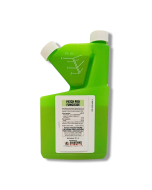Gain access to personalized product screening, the best pricing, rewards, and more!



application2
Ferti-Lome Centipede Weed and Feed 15-0-15
01/10/26
Ferti-Lome Centipede Weed and Feed 15-0-15, manufactured by VPG, is an easy to use combination granular fertilizer and herbicide. As a slow-release fertilizer it works to keep your lawns free from weeds for an extended period of time.
Ferti-Lome Centipede Weed and Feed 15-0-15 works as systemic control, once it is applied to the surface of the targeted weeds leaves it will absorb into the plants system to the roots for complete elimination. Termination from the roots will stop future weeds from emerging and germinating in the same area as previous weeds.
As a post-emergent weed control, fertilizer, and slow-release this product is ideal for providing a deeper, long lasting green color to your turf for future generations to enjoy.
Tools Needed
To use Ferti-Lome Centipede Weed and Feed Fertilizer you will need a push spreader and hand spreader. We recommend using a push rotary (broadcast) spreader to ensure you get even coverage over the turf. You will also need a scale to help you measure the correct amount of fertilizer in pounds, and a measuring tool to measure your turf area.
How to Use
- Step 1: Mow your grass at least 1 to 2 days before applying Ferti-Lome Centipede Weed and Feed 15-0-15, and then water the lawn one day prior to application.
- Step 2: Determine how much product to use by calculating the treatment areas square footage. If you are unsure of this, measure in feet and multiple the treatment areas length times the width (length X width = square footage). The standard application rate for Ferti-Lome Centipede Weed and Feed is between 3.2 to 4.0 lbs. of product per 1,000 sq. ft.
- Step 3: If you grass is not covered with dew when applying or not moist, then lightly sprinkle the lawn with water before applying the product. Once moist, load your spreader with the appropriate amount of Ferti-Lome Centipede Weed and Feed 15-0-15 and adjust the setting for your specific spreader model (check the label for details). If unsure of the spreader settings, test the set spreader on an area of grass. To test an application of 3.2 lbs. of product per 1,000 square feet of turfgrass: Check your spreader on 310 square feet and adjust to apply at the rate of 1 pound of product per 310 square feet. Testing for 4.0 lbs. of product per 1,000 square feet of turfgrass: Check your spreader on 250 square feet and adjust to apply at the rate of 1 pound of product per 250 square feet.
- Step 4: Begin broadcasting the Ferti-Lome Centipede Weed and Feed 15-0-15 at the edge of the lawn and walk all the way around the perimeter of the yard at a steady pace. Then walk back and forth across the yard to cover the space in the middle. Water the lawn 1 to 2 days after applying the product. A second reapplication should only be made when 30 days have passed from the first application.
Where to Use
Ferti-Lome Centipede Weed and Feed 15-0-15 can be used on residential or commercial lawns containing Kentucky Bluegrass, Fescues, Perennial Ryegrass, Bermudagrass, Zoysiagrass, St. Augustinegrass and Centipedegrass.
When to Use
Use Ferti-Lome Centipede Weed and Feed 15-0-15 in the early spring or middle of March when weeds are young and actively growing. Ideally, you will want to apply this product in the early morning, or on warm days with no rainfall predicted for at least 24 hours. A second application may be necessary for dense infestation of weeds or adverse seasonal conditions 30 days after the first application.
Safety Information
Ferti-Lome Centipede Weed and Feed 15-0-15 is safe to use around or pets when applied according to the product label. Always wear the appropriate personal protective equipment (PPE) when applying this product.
Special Considerations
Ferti-Lome Centipede Weed and Feed 15-0-15 cannot be used on Dichondra or St. Augustine Grass also known as Floratam. If applied to these turfs, it will cause minor discoloration.
| Restricted Use | No |
|---|---|
| Shipping Restrictions | AK, CA, DC, DE, HI, IA, ME, NH, NJ, RI, WY |
| Availability | Online |
| Signal Word | CAUTION |
| Keith's Pro Tip | "When spreading Ferti-Lome Centipede Weed and Feed 15-0-15, it is best if you move at a steady and quick pace, like a fast walk. This will help you evenly distribute the fertilizer. Move too slow, and you might get clumps of fertilizer. Move too fast, you might end up with light distribution or have product go in non-target areas. " |
| Target Pests Multi | Aster, Austrian Fieldcress, Bedstraw, Beggarticks, Bird Vetch, Bitter Winter Cress, Bitterweed, Black Medic, Black Mustard, Black-eyed Susan, Blackseed_Plantain, Blessed Thistle, Blue Lettuce, Blue Vervain, Bracted Plantain, Brassbottoms, Bristly Oxtongue, Broadleaf Dock, Broadleaf Plantain, Bulbous Buttercup, Bull Nettle, Bull Thistle, Bur Clover, Burdock, Burweed, Buttercup, Buttonweed, Canada Thistle, Carolina Geranium, Carpetweed, Catchweed, Catnip, Chickweed, Cinquefoil, Clover, Cockle, Cocklebur, Common Chickweed, Common Mullein, Common Purslane, Creeping Jenny, Crimson Clover, Cudweed, Curly Dock, Dandelion, Dichondra, Dock, Dogbane, Dollarweed, English_Daisy, False Dandelion, False Flax, Fiddleneck, Field Bindweed, Fleabane Daisy , Florida Betony, Florida Pusley, Frenchweed, Galinsoga, Goathead, Gumweed, Hairy Bittercress, Hairy Fleabane, Hawkweed, Healall, Heartleaf Drymary, Heath_Aster, Hedge Bindweed, Hedge Mustard, Hemp, Henbit, Hoary Cress, Hoary Vervain, Hop Clover, Horsenettle, Jimsonweed, Knawel, Knotweed, Kochia, Lambsquarters, Lespedeza, Mallow, Mexicanweed, Milk Vetch, Milkweed Bloodflower, Morningglory, Mouseear Chickweed, Mouseear Hawkweed, Mugwort, Musk Thistle, Narrowleaf Plantain, Narrowleaf Vetch, Nettle, Orange Hawkweed, Oriental Cocklebur, Oxalis, Oxeye Daisy, Parsley Piert, Parsnip, Pearlwort, Pennycress, Peppergrass, Pigweed, Plains Coreopsis, Plantain, Poison Ivy, Poison Oak, Pokeweed, Poorjoe, Prairie Sunflower, Prickly Lettuce, Prickly Sida, Prostrate Pigweed, Prostrate Spurge, Prostrate Vevain, Prostrate_Knotweed, Puncture Vine, Purslane, Ragweed, Red Clover, Red Sorrel, Redroot Pigweed, Redstem Filaree, Rough Cinquefoil, Russian Pigweed, Russian Thistle, Scarlet Pimpernel, Scotch Thistle, Sheep Sorrel, Shepherdspurse, Slender Plantain, Smallflower Galinsoga, Smooth Dock, Smooth Pigweed, Sorrell, Sowthistle, Spanishneedles, Speedwell, Spiny Amaranth, Spiny Cocklebur, Spiny Sowthistle, Spotted Catsear, Spotted Spurge, Spurweed, Stinging Nettle, Strawberry Clover, Tall Nettle, Tall Vervain, Tansy Mustard, Tansy Ragwort, Thistle, Trailing Crown Vetch, Tumble Mustard, Tumble Pigweed, Velvetleaf, Venice Mallow, Virginia Buttonweed, Virginia Creeper, Virginia Pepperweed, Water Pennywort, Wavyleaf Thistle, Western Clematis, Western Salsify, White Clover, White Mustard, Wild Aster, Wild Buckwheat, Wild Carrot, Wild Four-o’clock, Wild Garlic, Wild Geranium, Wild Lettuce, Wild Marigold, Wild Mustard, Wild Onion, Wild Parsnip, Wild Radish, Wild Rape, Wild Strawberry, Wild Sweet Potato, Woodsorrel, Woolly Croton, Woolly Morningglory, Woolly Plantain, Wormseed, Yarrow, Yellow Rocket, Chicory, Dogfennel, Elderberry, Goldenrod, Ground Ivy, Matchweed, Mustard, Sweet Clover, Vetch |
| Time to Kill | After applying Ferti-Lome Centipede Weed and Feed 15-0-15, results will be seen within 30 days. For dense weed populations, a second reapplication may be made when 30 days have passed from first application. |
| Chemical Type | Fertilizer |
| Formulation | Granular |
| Application Methods | Granular Spreading |
| Product Drawbacks | Ferti-Lome Centipede Weed and Feed 15-0-15 can possibly cause discoloration of non-targeted plants. |
| Active Ingredient | Dimethylamine salt of MCPP-P 0.29%, Dimethylamine salt of 2,4-dichlorophenoxyacetic acid 0.17%, Dimethylamine salt 0.07%, Nitrogen 15%, Soluble Potash 15%, Boron 0.02%, Copper 0.05%, Iron 3.00%, Manganese 0.05%, Zinc 0.05% |
| Application Equipment | Gloves, Hand Spreader, Push Spreader |
| Mix Rate | Apply 3.2 to 4.0 lbs. of Ferti-Lome Centipede Weed and Feed 15-0-15 per 1,000 sq. ft. |
| Use Sites | Outdoors |
| Yield | One 20 lbs. bag of Ferti-Lome Centipede Weed and Feed 15-0-15 will cover up to about 6,700 sq. ft. |
| EPA Registration No. | 2217-603-7401 |
| Shelf Life | Ferti-Lome Centipede Weed and Feed 15-0-15 will last between 3 to 5 years when stored in a dry, cool place away from water, food, and feed. Any open product bags containing unused Ferti-Lome Centipede Weed and Feed 15-0-15 should be kept in a tightly sealed storage area inaccessible to children and domestic animals. |
| Comparable Products | Solutions 15-5-10 Weed & Feed Fertilizer |
| Children or pets? | No |
| Property Characteristics | None |
| Availability | Online |
| Restricted Use | No |
| Brand | VPG |
| Keith's Pro Tips | "When spreading Ferti-Lome Centipede Weed and Feed 15-0-15, it is best if you move at a steady and quick pace, like a fast walk. This will help you evenly distribute the fertilizer. Move too slow, and you might get clumps of fertilizer. Move too fast, you might end up with light distribution or have product go in non-target areas. " |
| Product Drawbacks | Ferti-Lome Centipede Weed and Feed 15-0-15 can possibly cause discoloration of non-targeted plants. |
| Target Pests | Annual Yellow Sweetclover, Aster, Austrian Fieldcress, Bedstraw, Beggarticks, Betony Florida, Bindweed Field, Bird Vetch, Bitter Wintercress, Bittercress Hairy, Bitterweed, Black-Eyed Susan, Black Medic, Black Mustard, Blackseed Plantain Blessed Thistle, Bloodflower Milkweed, Blue Lettuce, Blue Vervain, Bracted Plaintain, Bristy Oxtongue, Broadleaf Dock, Broadleaf Plantain, Broomweed, Buckhorn, Buckhorn Plantain, Bulbous Buttercup, Bull Thistle, Bullnettle, Burclover, Burdock, Burning Nettle, Burweed, Buttercup, Buttonweed, Canada Thistle, Carolina Geranium, Carpetweed, Catchweed, Bedstraw, Catnip, Catsear, Chickweed, Common Chickweed, Mouseear, Chicory, Cinquefoil, Clover Crimson, Clover Hop, Clover Red, Clover Strawberry, Clover Sweet, Clover White, Cockle, Cocklebur, Common Mullein, Creeping Jenny, Cudweed, Curly Dock, Daisy English, Daisy Fleabane, Daisy Oxeye, Dandelion, Dichondra, Dogfennel, Dollarweed, False Dandelion, Falseflax, False Sunflower, Fiddleneck, Florida Pusley, Frenchweed, Galinsoga, Goldenrod, Ground Ivy, Gumweed, Hairy Fleabane, Hawkweed, Healall, Heartleaf Drymary, Heath Aster, Hedge Bindweed, Hedge Mustard, Henbit, Hoary Cress, Hoary Plantain, Hoary Vervain, Horsenettle, Jimsonweed, Knawel, Knotweed, Kochia, Lambsquarters, Lespedeza, Mallow, Matchweed, Mexicanweed, Milk Vetch, Morningglory, Mouseear, Hawkweed, Mugwort, Musk Thistle, Mustard, Narrowleaf Plantain, Narrowleaf Vetch, Nettle, Orange Hawkweed, Oriental Cocklebur, Oxalis, Parsley-Piert, Parsnip, Pearlwort, Pennycress, Pepperweed, Pigweed, Pineywoods, Bedstraw, Plains Coreopsis, Plantain, Poison Ivy, Poison, Oak, Pokeweed, Poorjoe, Prairie Sunflower, Prickly Lettuce, Prickly Sida, Prostrate Knotweed, Prostrate Pigweed, Prostrate Spurge, Prostrate Vervain, Puncturevein, Purslane, Common Ragweed, Red Sorrel, Redroot Pigweed, Redstem Filaree, Rough Cinquefoil, Rough Fleabane, Russian Pigweed, Russian Thistle, Scarlet Pimpernel, Scotch Thistle, Sheep Sorrel, Shepherdspurse, Slender Plantain, Smallflower Galinsoga, Smooth Dock, Smooth Pigweed, Sorrel, Sowthistle, Spanishneedles, Speedwell, Spiny Amaranth, Spiny Cocklebur, Spiny Sowthistle, Spotted Catsear, Spotted Spurge, Spurweed, Stinging Nettle, Strawberry, India Mock, Tall Nettle, Tall Vervain, Tansy Ragwort, Tansy Mustard, Tanweed, Thistle, Trailing Crownvetch, Tumble Mustard, Tumble Pigweed, Velvetleaf Venice Mallow, Virginia Buttonweed, Virginia Creeper, Virginia Pepperweed, Wavyleaf Bullthistle, Western Clematis, Western Salsify, White Mustard, Wild Aster, Wild Buckwheat, Wild Carrot, Wild Four-O’clock, Wild Garlic, Wild Geranium, Wild Lettuce, Wild Marigold, Wild Mustard, Wild Onion, Wild Parsnip, Wild Radish, Wild Rape, Wild Strawberry, Wild Sweet Potato, Wild Vetch, Woodsorrel, Woolly Croton, Woolly Morningglory, Wooly Plantain, Wormseed, Yarrow, Yellow Rocket, Yellowflower, Pepperweed |
| Application Equipment | Gloves, Hand Spreader, Push Spreader |
| Application Methods | Granular Spreading |
| Active Ingredient | Dimethylamine salt of MCPP-P 0.29%, Dimethylamine salt of 2,4-dichlorophenoxyacetic acid 0.17%, Dimethylamine salt 0.07%, Nitrogen 15%, Soluble Potash 15%, Boron 0.02%, Copper 0.05%, Iron 3.00%, Manganese 0.05%, Zinc 0.05% |
| Product Type | Fertilizer |
| Formulation | Granular |
| Application Rate | Apply 3.2 to 4.0 lbs. of Ferti-Lome Centipede Weed and Feed 15-0-15 per 1,000 sq. ft. |
| Shelf Life | Ferti-Lome Centipede Weed and Feed 15-0-15 will last between 3 to 5 years when stored in a dry, cool place away from water, food, and feed. Any open product bags containing unused Ferti-Lome Centipede Weed and Feed 15-0-15 should be kept in a tightly sealed storage area inaccessible to children and domestic animals. |
| Yield | One 20 lbs. bag of Ferti-Lome Centipede Weed and Feed 15-0-15 will cover up to about 6,700 sq. ft. |
| Use Sites | Outdoors |
| Time to Kill | After applying Ferti-Lome Centipede Weed and Feed 15-0-15, results will be seen within 30 days. For dense weed populations, a second reapplication may be made when 30 days have passed from first application. |
| Comparable Products | Solutions 15-5-10 Weed & Feed Fertilizer |
| Use Caution With | Bentgrass, St Augustine |
| EPA Registration # | 2217-603-7401 |
*Price does not include freight. We guarantee our rate plus shipping will be less than anyone else's price.










